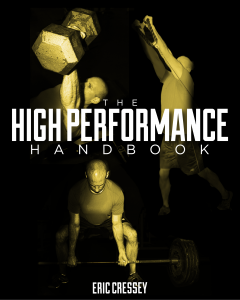
Strength Training Programs: How Many Sets and Reps? – Part 1
Q: I know this is a loaded question with hours upon hours of answers, but I’m trying to make some sense about the different kinds of ways/philosophies involved in writing strength and conditioning programs. I have read different articles and chapters in books that discuss program development, looked at programs at my current job, and can write a basic one for a new athlete. It’s not the exercises; I’m familiar with plenty and love seeing something new. My problems come more with the sets and reps and when they change and why; I can’t seem to map out the actual progression of the program.
What philosophies, if one, do you follow and what basic rules do you find to be the most important when determining the sets and reps?
A: This is a loaded question! The best way to get better with programming is simply to write a ton of programs and see what works and what doesn’t. However, with respect to your specific questions on sets and reps, what you choose to utilize is going to be dictated by:
1. The duration of a session – You won’t be able to do 6 sets of 4 reps if you only have an client/athlete for an hour and want to accomplish other things. This is, in particular, a big issue in collegiate strength and conditioning programs because the NCAA allows only limited number of hours per week with athletes, and sport coaches and strength and conditioning coaches have to share this time. Additionally, it’s a challenge for personal trainers in private training set-ups where clients may train in 30-, 45-, or 60-minute blocks.
I’ve written several times in the past about how I would never allow our business model to dictate our training model – and this sets and reps question is one reason why. At Cressey Sports Performance, we do all semi-private training, which allows for sliding starts and finishes. It allows us to get in all the work we need to do with clients – regardless of the sets and reps in question. Likewise, as you’ll see in the rest of this two-part series, you’ll appreciate that it’s why we don’t have one program standardized for everyone on the dry erase board; every single CSP client has a unique program because they all have unique needs.
2. Competing demands – The more variety (plyos, conditioning, medicine ball work, etc) that you want to add to a program, the less volume you’ll be able to do on strength training. We have limited time and recovery capacity, so we can’t just keep adding all the time.
For me, a good example is what happens over the course of the baseball off-season. Lifting volume is high when they get back, throwing is a no-go, movement training is 2x/week, and medicine ball is light. After the first month, medicine ball work goes up, lifting comes down a bit.
Then, at the start of January, medicine ball and lifting volume comes back down and throwing volume increases. We then get rid of medicine ball work almost altogether and go to 3x/week movement training as the season approaches, throwing intensifies, and guys do more hitting. So, it doesn’t just depend on the exercises; it depends on the big picture.
A great follow-up read to this point would be my post, Weight Training Programs: You Can’t Just Keep Adding.
3. Exercise selection – If you’re doing more sets, you’ll want to do it on “money” exercises like deadlifts and not curls, etc. Moreover, certain exercises lend themselves better to higher reps than others. For instance, we never front squat anyone over six reps, because technical breakdown often occurs with fatigue. You also wouldn’t want to do cleans for sets of 15!
Usually, it’s also good to just “call it” on a particular exercise and move on to the next if someone has already dropped the weight on subsequent sets and form continues to deteriorate. That energy is better spent on different exercises where technique can remain perfect even in the presence of fatigue.
4. Training age – As a general rule of thumb, the more experienced they are, the more sets and FEWER reps they’ll need. At this point in my training career, I just won’t get strong on sets of five. Here’s another good follow-up read: Why I Don’t Like the 5×5 Workout.
Conversely, beginners generally need more sets and reps to pick up on things. That doesn’t mean that you should just do three sets of 15 reps on everything with a novice, though. I find myself teaching squat and deadlift variations with four sets of five reps quite a bit; the load, however, is light enough that the lifter could usually do 10-12 reps. In other words, it’s just technique practice.
5. The Training Goal and Client/Athlete in Question – While taking heavy singles over 90% of one’s 1-rep max may be ideal for helping folks get strong, working at such a high percentage in some populations warps the risk: reward circumstances. Whether it’s older folks, those with injuries, or athletes who have a lot more to lose by getting hurt than they have to gain by adding five pounds to their squat, you have to take each individual situation into consideration. I always remind people that we lift weights to improve quality of life, not just so that we can talk about how heavy the weights we lifted were.
6. Whether You Want to Impose or Remove Fatigue – In a “loading” week, volume is going to be higher. If you’re deloading, though, that volume is going to be reduced. Aside from beginner strength training programs, volume should never be the same over several weeks in a row. I discuss several deloading strategies in my e-book, The Art of the Deload.
I’ll be back in a tomorrow with more factors that influence the sets and reps in a strength training program. In the meantime, if you’re looking for a comprehensive strength and conditioning program to take all the guesswork out of things for you, check out The High Performance Handbook.




